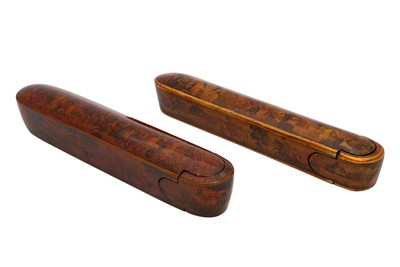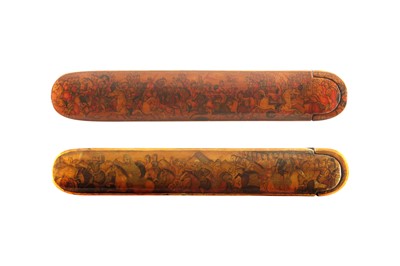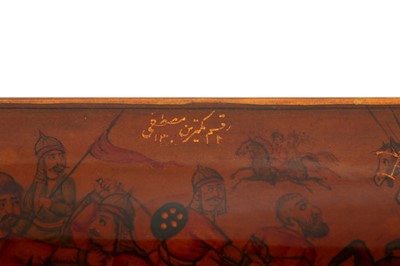29th Apr, 2022 11:00
Islamic Art - Property of a European Collector Part III
TWO LACQUERED PAPIER-MÂCHÉ PEN CASES (QALAMDAN) WITH BATTLE SCENES
Qajar Iran, late 19th century, one dated 1302 or 1304 AH (1884 or 1886 AD)
TWO LACQUERED PAPIER-MÂCHÉ PEN CASES (QALAMDAN) REPLICATING THE SAME BATTLE SCENE OF SHAH ISMA'IL FIGHTING THE OTTOMAN TURKS
PROPERTY FROM AN IMPORTANT EUROPEAN PRIVATE COLLECTION
Qajar Iran, late 19th century, one dated 1302 or 1304 AH (1884 or 1886 AD)
Each with rounded ends and sliding tray, lacquered, polychrome-painted and heightened in gold, the horizontally arranged curved top of both pen cases depicting a momentous battle in Persian history when the first Safavid ruler Shah Isma'il (r. 1501 - 1524) fought against the Ottoman Turks (possibly the battle of Chaldiran in 1514), the two armies shown here in fierce combat in the foreground and further soldiers joining the scene in the hilly background, one pen case also depicting a stylised row of cannons, weapons the Ottomans used with increased frequency in the early Safavid period, the sides of one pen case with bucolic scenes of shepherds and soldiers lost in the wilderness asking for directions, and on the latter stylised hunting scenes, the sides of the sliding tray and underside of one pen case with charming rosette sprays and saz leaves in gold against a red ground, and the latter plain black, the largest pen case signed and dated in gold on the top The Work of the Humblest Mustafa 1302 / 4 (?), the longest 22cm.
The subject of the battle between Shah Isma'il and the Ottomans must have been a popular and recurrent one in the production of Qajar qalamdans. Indeed, the scene on our two pen cases is exactly the same, just the quality of its draughtsmanship differs. A qalamdan depicting the same battle, dating to the early 19th century and attributed to the master court painter Mirza Baba (active 1780s – 1810) or an artist in his circle is part of the permanent collection of the Metropolitan Museum of Art in New York (acc. no. 2006.523a, b), published in M. Ekhtiar, Sheila R. Canby, N. Haidar, and Priscilla P. Soucek, ed. Masterpieces from the Department of Islamic Art in The Metropolitan Museum of Art. 2011. cat. 193, p. 276. Another similar pen case is part of the Brooklyn Museum collection, showing the wide availability and popularity of qalamdans depicting this subject. The sides, however, appear to be different on the four pen cases, suggesting that the maker's individual creativity was only encouraged on the less visible parts of the object.
It is particularly interesting to notice and compare the pictorial evolution of a falling horse on the right side of the pen case. In the MET example, the horse is shown slightly tilted to the right, his crest and head out of sight suggesting they were already on the ground or hidden by other soldiers on horseback joining the scene. In our examples instead, the horse body has been painted in a vertical position, the rider falling off behind. Paradoxically, the horse's crest and head are missing, leaving a face-less horse. These comparisons are indicative of how the artists' ateliers worked at the time: painters were trained and asked to replicate images and scenes considered of the highest quality over and over through the years, without amending or perfecting them, weaving an unbreakable thread with the work of the great masters that preceded them.
Sold for £1,500
Includes Buyer's Premium
Do you have an item similar to the item above? If so please click the link below to submit a free online valuation request through our website.





